|
back to spaceweather.com |
| Summary: Space Shuttle Discovery (STS-116) lifted off from the Kennedy Space Center on Saturday, Dec. 9, 2006, at 8:47 pm EST. It was a spectacular night-time launch seen as far away as Long Island, New York. The shuttle proceeded to the ISS for an 8-day visit, delivering 4,292 pounds of supplies and equipment. Working together with astronauts already onboard the ISS, they added a new truss segment and re-wired the station to tap power from two solar arrays installed in September: full story. Unless otherwise stated, all images are copyrighted by the photographers. |
| Photographer, Location | Images | Comments | |
|
[listen] |
Mike
Theiss, Kennedy Space Center, Florida Dec. 9, 2006 |
#1, #2, #3, more | Turn up the volume. Photographer Mike Theiss was at the Kennedy Space Center and he recorded the sound of the shuttle's engines: listen. "The crackling sound you hear is not a distortion. The launch really did sound like that," he says. "It was awesome." |
|
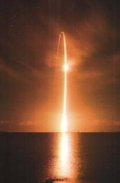
|
Merlon
D. Mayrand, Titusville, FL. Dec. 9, 2006 |
#1, #2 | I took this shot from across the Indian River in Titusville, FL. The building to the right of the shuttle launch is the Vehicle Assembly Building aka VAB. It is about 500 feet high. In the first picture (#1) the Space Shuttle is shown punching a hole in the clouds. In the second picture (#2) we see the shuttle heading down range. Photo details:
Olympus OM-2N. Fuji 200 negative film, 50 mm lens, F8. |
|
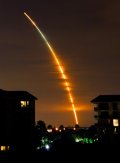
|
Jose
Suro, St. Petersburg, Florida Dec. 9, 2006 |
#1, more | Even from 250km (155 miles) away and through clouds a shuttle launch looks very bright at night. This was taken from the west coast of Florida. I used a 1-minute and 30-second exposure at F13 |
|
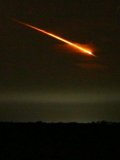
|
Mark
A. Brown, Tyndall AFB, Florida (Florida Panhandle) Dec. 9, 2006 |
#1 | 400 miles from the launch site: This is the night launch of Space Shuttle Discovery as it climbed out of the haze near the horizon. The shuttle was approximately 5 degrees above the horizon when it became visible. I was able to see the shuttle for about 40 seconds prior to Solid Rocket Booster (SRB) separation. It was much more brilliant than planet Jupiter or Venus....more like a -5 magnitude Iridium Flare flickering in the night sky. It was incredibly bright and faded quickly after the boosters separated... (approx. 10 degrees above the horizon). Photo details: Canon Digital Rebel, ISO 1600, 50mm lens at f/5 |
|
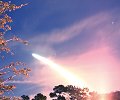
|
Alvaro Garay,
Casselberry, Florida, USA Dec. 9, 2006 |
#1, #2 |
Very exciting experience watching a launch from home. You could see the two rockets falling behind the Discovery. Photo details: Canon Rebel XT. The first photo was 40 seconds at f/6.3 and the second one was 26 seconds at f/6.3, both ASA 400. |
|
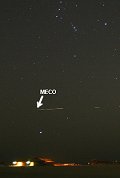
|
Bill
Bradley, Robert Moses State Park, Long Island, NY. Dec. 9, 2006 |
#, | First appearance was due south from the parking field approx. 7 1/2 minutes after launch. The main engine produced an orange yellow glow. MECO (main engine cut off) was not sudden. It went out just south of east then flared back on twice followed by a steady glow before finally disappearing in the south east past Orion. |
|
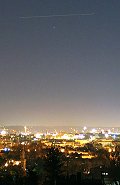
|
Geoff
Chester, U.S. Naval Observatory, Washington, DC Dec. 9, 2006 |
#1, | I had a great view from the parapet of the 12-inch telescope at USNO, where I was representing the Observatory for the annual meeting of the Marine Technology Society. The shuttle appeared quite suddenly about 7 minutes after liftoff, probably at the completion of the "heads-up" roll maneuver. STS-116 is the trail along the top center of the image, above the stars Procyon and Beta CMi. The trail at lower left is an airplane. Photo details: Canon PowerShot A95, 10-second exposure, ISO 200, f/4.5, no zoom. |
more images: from Robert Jeffers of Virginia Beach, Virginia.


